The famous
Stele of Diaoskourides a thureophoros in the Ptolemaic
army.
Thureophoroi
in 28mm
Backbone of the
Hellenistic Army
Here
is my impression of a thureophoroi game regiment,
the backbone of any Successor army. They are the old
expendables.
This unit consists of mixed 28mm figures from Old
Glory,Newline Designs, and A&A figures. Some models
have been converted slightly. Some have Essex shields.
The color scheme is from an Angus McBride painting in the
famous Montvert book on the Seleucid army, by Nick
Sekunda.
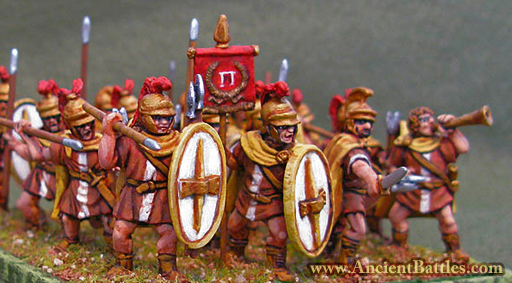
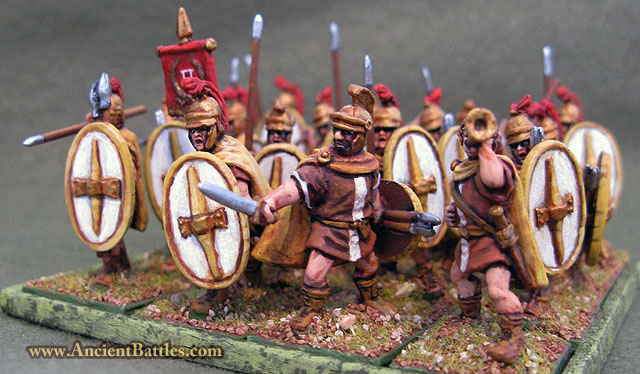
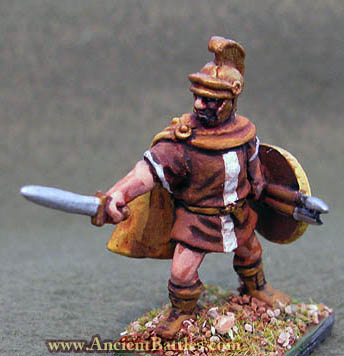


The
standard is from my ancient stash of Ral Partha
items. The standard bearer is an A&A command
figure with an Old Glory head swap.
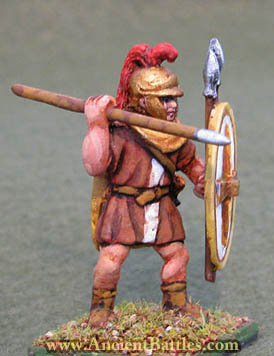

The Newline Designs Figure on the left has an Essex shield with nice molded on javelins.


Images
by Angus McBride that inspired the models, note that
one fellow has a round bronze faced shield instead of
a thureos. Also notice that often
figure sculptors miss the fact that the
Successor
version of the thureos is often much more
streamlined, with a elongated and rounded boss
and often without the rectangular reinforcing
plate tacked on the front. I'm
hoping the new next generation of figures will
address this nuance. When boss plates are
shown on funerary stele they are often in a more
interesting shapes such as on the stele of
Dioskourides at the top of the page.

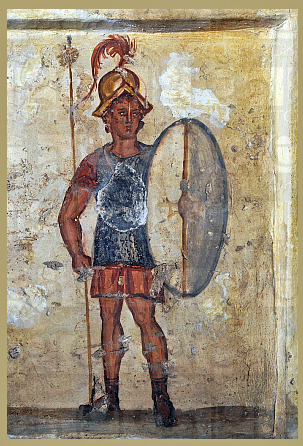
Actual sources. Grave Stelai with frescoes have
survived to reveal these soldiers more than many
others of the period.
Thureophoroi:
Backbone of the Hellenistic Army
The thureophoros is the ubiquitous Hellenistic mercenary. Phalanxes, war elephants, and armored cavalry may have stolen the glory in the infrequent large battles, but the majority of work fell on mercenaries who patrolled the borders, guarded fortifications, and assaulted cities. The thureophoros, like many ancient warriors gains his name from the shield he carries. This is the Greek version of the Celtic shield they mocked, calling it a "door stop" because it was shaped like the oval stones the Greeks used to prop open doors. The commentators openly describe that the thureos offered little protection to the Galatians as they were set upon by Aetolian missiles. But soon after the Galatians were thrown out of Greece, mercenary soldiers began to adopt it as an alternative to the heavy bronze faced hoplite shield.
As the wars between the Successors dragged on over time, their need for cheap useful mercenaries was insatiable. Eventually the thureophoroi, as the soldiers became known, served in most Successor armies. Contingents of Achaeans and Aetolians are cited in the great battles and frontier skirmishes. The Greeks who were instrumental in the Ptolemaic victory at Raphia are likely to have been thureophoroi. Asia and the levant was another great source of hired manpower. The image above (left) is a Lycia, from the town of Balbura (near modern-day Çölkayiği, Turkey). Lycians, Pisidians, and Carians were major sources of merceanries for the Successor armies. His funerary stele is in the Istanbul Museum. He is a typical thureophoros, armed with a straight sword attached to a baldric, and a Successor style helmet with a reinforced crown and crest. He wears laced boots, and a crimson tunic. His thureos is white with bronze handle boss and edging. Thureophoroi on the battlefield were often deployed on the wings in position to cover the flanks of the phalanx. Their smaller formations were more flexible and able to cover more ground quickly. This made them well suited to swiftly move forward and protect a flank of a more rigid phalanx. The tactic wasn't new as Pyrrhus of Epirus used Samnite troops to bridge the gaps of his phalanx and help it from being penetrated by Roman Maniples. Thureophoroi also had the dual role of skirmishing or working in rougher ground. They probably traded their spears for javelins for this role, or they may have used both if needed.
The
normal routine of the thureophoroi was not pitched battle,
but the more constant duty of guarding lines of
communication, and defending the forts that separated states
in greater numbers than ever before. As the armies
pushed on to invade the enemy turf, the thureophoroi were
needed to garrison and occupy the lands. When Parthian
raiders swept into Judea, the Ptolemaic thureophoroi would
be those who marched out to drive them away. The
mercenary thureophoroi of Pergamum were the first line of
defense against the Galatians who had set up a brigand state
in Anatolia. In the great sieges the generals got
their fodder from the thureophoroi.... the men who pushed
the rams, and pulled the giant siege towers into position...
men who were more expendable than settlers and ethnic
Macedonians.
Rations are expensive but men are cheap, sounds like a line from the magnificent seven! This example is a bit early for the thureos, but it shows how brutal Demetrius was....
 |
I have taken the liberty to
colorize one of Ian Heath's images from AMPW* at left.
This figure shows the controversial 'dual armament' of
the thureophoros. Some folks have
recently attacked the idea of both spear and javelins
being carried together. Most funarary art show
spears or javelins, rarely both.
Since it is not impractical that soldiers could carry and use both it is often judged irrelevant. But the thureophoros would usually take specific role in a combat situation, and it seems unlikely a soldier would carry a spear to a skirmish, or extra javelins if he was going to fight in close order in the battle line. On guard duty a spear is more likely, and maybe both spear and javelins should be handy if defending a frontier fort from Parthian raiders, Saka tribemen, Nubians, or Nabataean brigands. Cloaks may or may not have been worn in combat and may have been given out as rewards in Successor armies. There is really no way to tell if uniformity was the norm. Mercenaries may have been outfitted by their Successor paymasters, but it's just as likely they showed up with what gear they had. One of the reasons for the increased availability of mercenary soldiers was the cheapness of the thureos and their gear, since a bronze faced hoplite shield is an expensive investment. However, in the end the constant wars drained manpower from Greece, as the young men were lured away from the small farms and were rewarded with land in Asia or Egypt, or on the Oxus in Afghanistan.
* Duncan Head's "Armies of the Macedonian and Punic Wars" (AMPW) is still the best overall source for Successor uniform information. |
Here are two images of terracotta thureos
shields found in the "tomb of the Erotes" near Eretria.
The soldiers interned here were likely from an Antigonid
Macedonian garrison. The interesting thing here is these
show very ornate decoration and multiple colors on the
thureos in relief. They are also much narrower than
usually depicted.
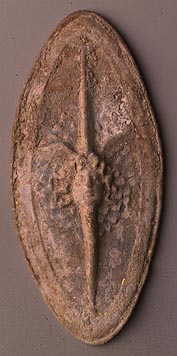

An Ascalon (or Thraco-Attic) style helmet, the typical headgear of the thureophoros in Ptolemaic, Seleucid, and Pergamene service:


New announcement of plastic 28mm Thureophoroi to come from Wargames Atlantic:

Link:
https://wargamesatlantic.com/blogs/news/new-set-announcement-thureophoroi
Also Relic Miniatures have their own excellent
Thureophoroi and Thorakites models:
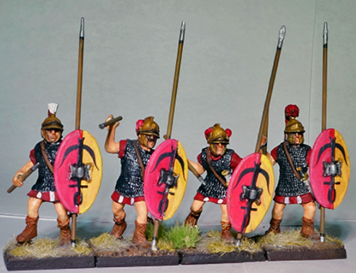

Link:
https://www.relicminiatures.com/product-category/successors/page/2/
Aventine 28mm Thureophoroi


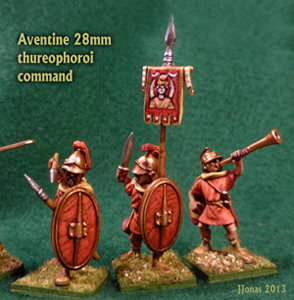



Polemarch thorakites 28mm (before shield design finished)

Battle in the glass case
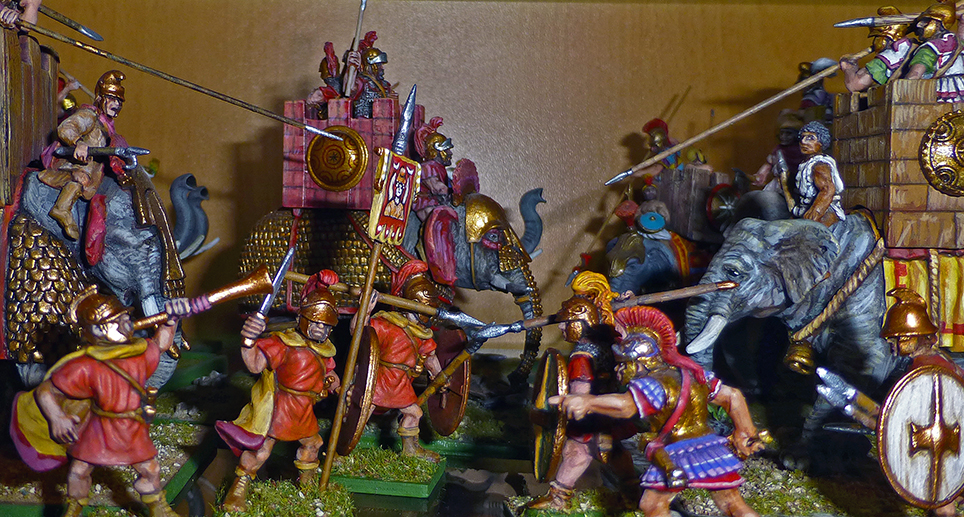
Old Timers
Thorakites in true 25mm, my old guards by Naismith, with a RAFM offcier from the 1980's
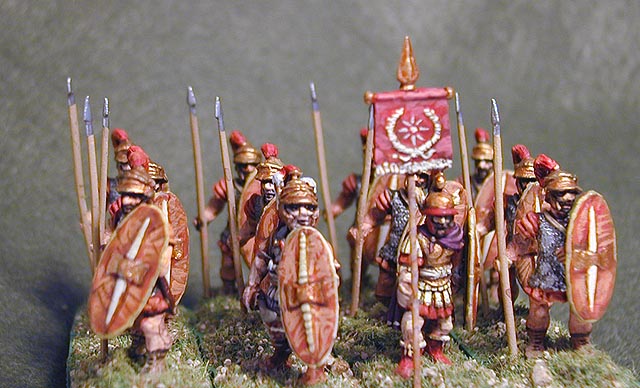
Newer models far outshine my oldest unit of thureophoroi, these being MiniFigs and RAFM true 25mm figures from the 1970's and 1980's (below).
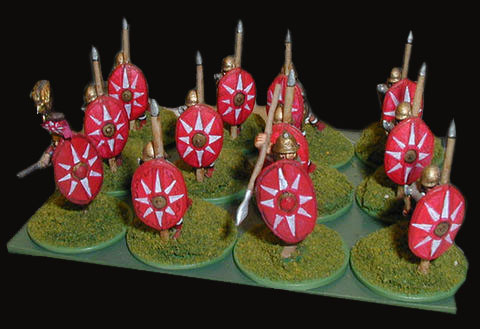

And there are still more models from various sources:
1st Corps has an extensive range:
http://www.kingmakerminiatures.net/catalog/
Polemarch has thureophoroi and Thorakites sculpted by Steve Saleh:
http://grippingbeast.com/webpage.php?PageID=74
Crusader has a nice set of command and rank and file:
http://www.crusaderminiatures.com/
Magister Militum has expanded their range :
http://www.magistermilitum.com/
I'm going to use these A&A peltast figures as Greek thureophoroi,
Achaeans or Aetolians, all I need is some more shields:
http://www.aandaminiatures.co.uk/
Old Glory as shown below painted by Don Effinger:
http://www.oldgloryminiatures.com/
Newline Designs 28mm figures are now available through SHQ:
http://www.shqminiatures.co.uk/Ranges/25mmAncients/Ancientsmain.php?UID=2009021416221971.137.3.66

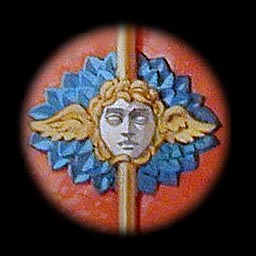


Where do you want to go next? Click on: Site Map